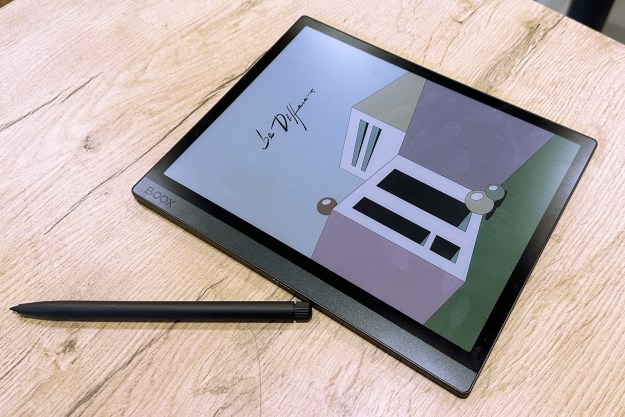It’s easy to forget how difficult it was to find places in the days before Google Maps, but for all the improvements we’ve seen in outdoor navigation guides, we still lack a reliable way to get where we’re going inside. The Tango App experience was created by Google and Lenovo to demonstrate the potential of Project Tango and augmented reality to help us navigate indoors and find people and places.
During Mobile World Congress, we were given a guided tour of the modern art section of Barcelona’s stunning Museu Nacional d’Art de Catalunya which sits atop Montjuic hill. But our tour guide wasn’t a person, it was an augmented reality app on a tablet.
It was like having an insanely convenient version of Wikipedia with us at the museum.
Lenovo was able to quickly map out an area of the museum reserved for the MWC demo and mark specific points of interest using Project Tango tablets and special software called GuidiGo. The app guided us to certain artworks via a trail of blue dots on the floor visible on the tablet screen and announced when we reached our destination.
Once there, there was even more augmented reality to try. By holding the tablet up in front of a painting and tapping on specific highlighted spots we were able to access more details about the characters portrayed within pieces of art, and dip into all sorts of related information. It was like having an insanely convenient version of Wikipedia with us at the museum.
It’s easy to imagine the possibilities for technology like this. It could be used to help guide you through confusing underground stations, take you directly where you want to go in a shopping mall, or even help you find someone within a crowded building.
In the lobby of the demo area, some Project Tango tablets were using Glympse software to display where people (who had specific devices) were by showing avatars above their heads. If they were in another room or downstairs, the avatar was displayed smaller or on the floor. If they were in the room it would appear directly above their heads.
The software isn’t perfect, though. Occasionally, the trail of blue dots tried to take us through a wall, like we’re a ghost or something, but when we did take a wrong turn it simply recalculated our route, like Google Maps.
The real stumbling block for anyone interested in using this technology right now is the lack of any available hardware, but at CES back in January Lenovo announced that it would release a smartphone with 3D imaging support in the U.S. this summer.
Project Tango has the potential to do the same for indoor navigation as Google Maps has done for outdoor navigation. Once the technology is widely available there’s real scope for destinations to be fully mapped in interesting ways through crowdsourcing. We could have indoor guides to museums, art galleries, malls, and all kinds of other venues with points of interest marked with expandable AR content. Of course, one barrier may be businesses and establishments themselves. Before Google, or any company, can make an indoor map, they must obtain permission from whoever owns the building or space. For years, this has been one of indoor mapping’s biggest challenge, and one of the reasons why only a small number of buildings have indoor maps right now.
Our trip round the museum was brief, but inspiring. This is exciting technology, and definitely an overdue innovation. We imagine it coming in handy at sports stadiums or in places like Las Vegas casinos, where layouts are a nightmare and it’s easy to get lost, but the ability to layer AR information onto any surface also opens up a huge array of possibilities. Future grocery stores could announce sales and help you find products to buy, for example, or just guide you directly to the box of Oreos you shouldn’t buy.
We can’t wait to really learn how to Tango with Lenovo later this year.




